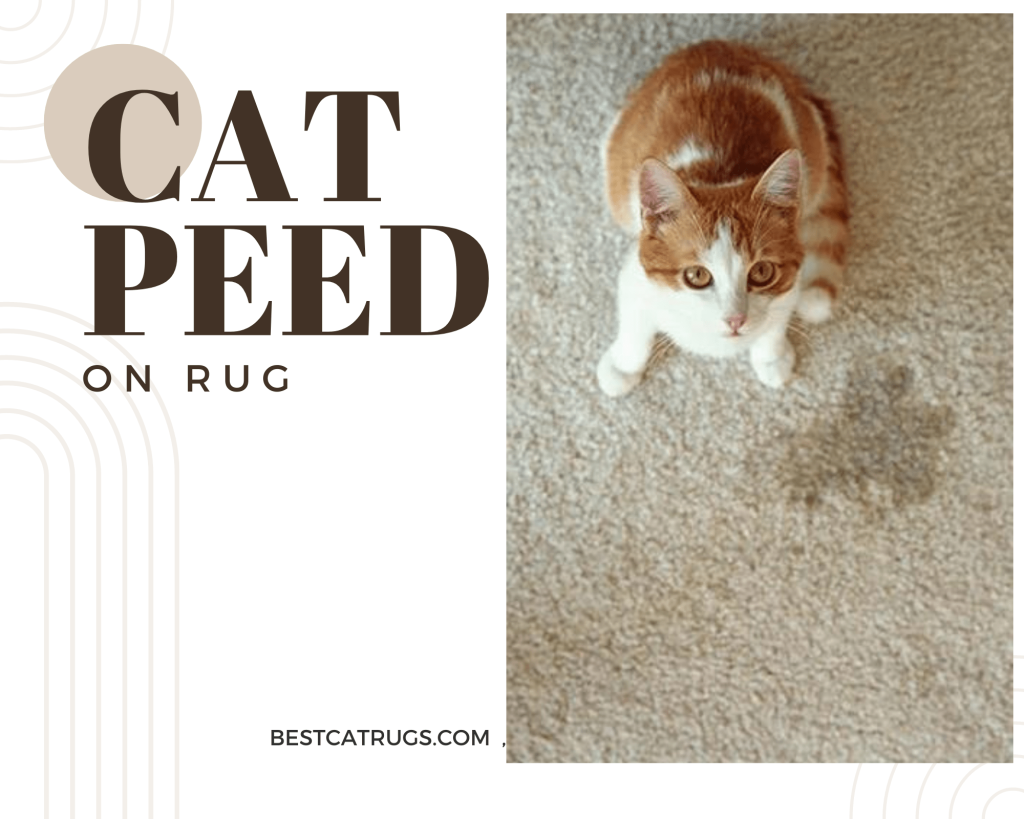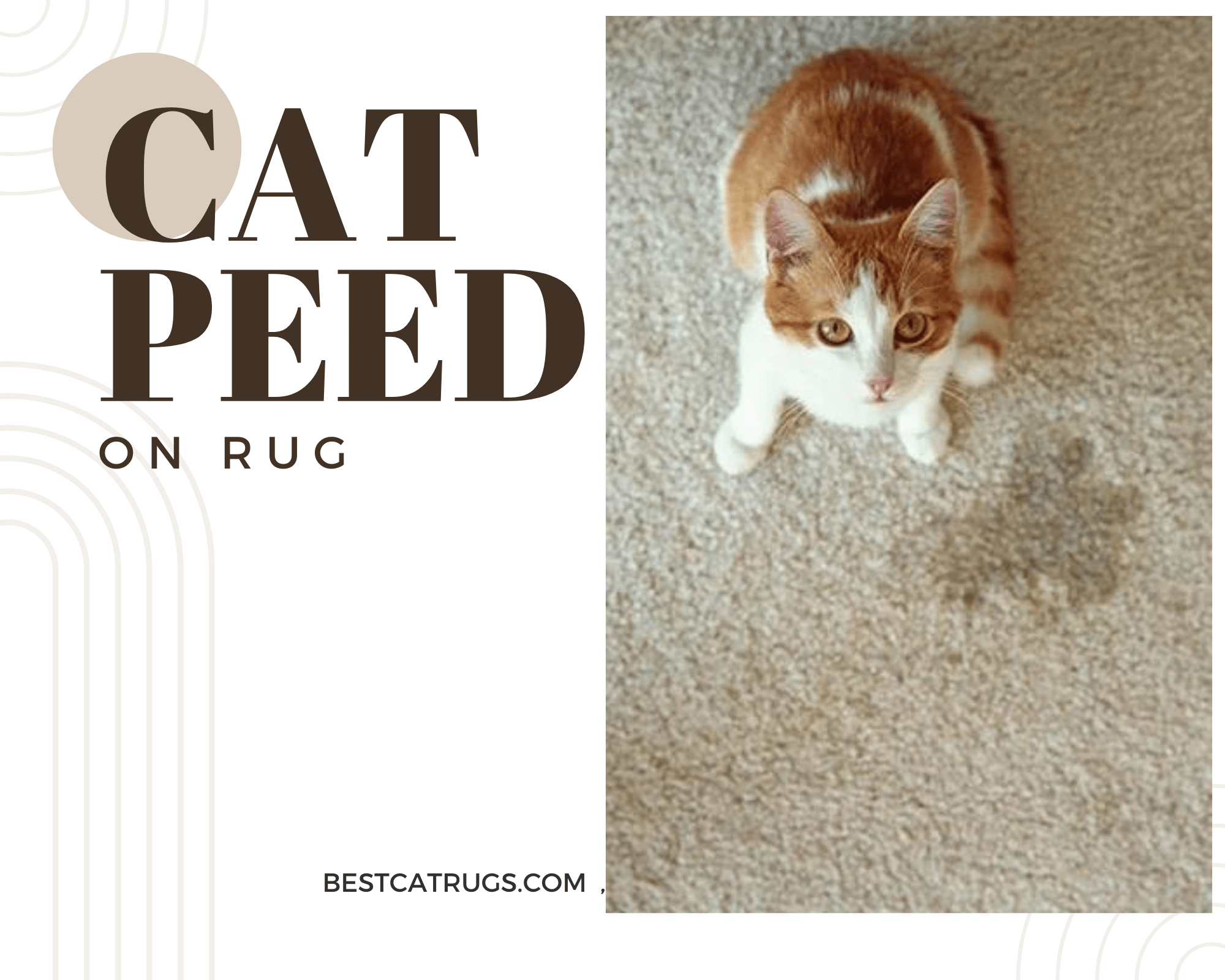Nothing could be more jarring and frustrating than coming home after a long day to the unpleasant sight and smell of cat urine on your favorite rug. Aside from soiling your rug, it also leaves you grappling with the persistent question: why did your cat choose to pee outside the litter box? Although often a source of irritation and bewilderment for cat owners, understanding this complex behavior can be the first step to solving the problem. This comprehensive guide offers an in-depth exploration into why cats pee on rugs, how to clean and manage the aftermath, and strategies for preventing unwanted behavior.

Deciphering the Underlying Reasons
By nature, cats are clean and fastidious creatures that use their litter boxes religiously. If your feline companion has started to urinate outside its litter box, there could be various reasons for this. Here are some potential culprits Cat Peed On Rug :
Medical Conditions
The sudden change in your cat’s behavior might be a cry for help. Urinary tract infections (UTIs), kidney diseases, diabetes, or bladder stones can cause discomfort and make it difficult for your cat to pee. They may associate the litter box with this pain and avoid it, opting for the rug instead.
Behavioral Concerns
Cats possess a remarkable sensitivity to alterations in their surroundings. Something as minor as rearranging furniture or as significant as adding a new pet or family member could cause stress and anxiety, leading to inappropriate urination. Cats might also mark their territory, especially in multi-cat households, which might involve urinating on prominent objects like rugs.
Litter Box Issues
If the litter box is not up to your cat’s cleanliness standards, they might avoid it. Factors such as periodic cleaning, a change in litter type, or the box’s location can contribute to your cat choosing the rug over the litter box. In multi-cat households, some cats might refuse to share a litter box, leading to similar behavior.
Cleaning Cat Urine: A Thorough Approach
The key to managing cat urine on your rug is to act promptly and clean it correctly. This is crucial to protect your rug and discourage your cat from urinating on it again. Cats have a keen sense of smell; if they can still smell the urine, they might consider the rug a proper place to pee. Here’s a meticulous approach to cleaning up cat urine effectively:
Step 1: Blot and Absorb
Use a highly absorbent material like paper towels or cloth to blot the spot. This will soak up most of the urine, especially wet ones. It’s important not to rub or scrub at this stage, as it can push the urine more profound into the rug’s fibers.
Step 2: Apply an Enzyme Cleaner
Enzyme cleaners are the most effective products for breaking down and eliminating the odor-causing chemicals in cat urine. These cleaners contain specific enzymes that target and decompose the urine, removing the stain and the odor at its source.
Step 3: Rinse and Extract
After applying the enzyme cleaner, rinse the area with cold water to remove residual urine or cleaner. You can use a wet vacuum to extract the water and leftover debris. Avoid using a steam cleaner, as heat can set the stain and odor.
Step 4: Air-Dry the Rug
Allow the rug to air-dry completely. Residual moisture can lead to mold or mildew, presenting an entirely separate set of issues. You can also use fans to expedite the drying process.
Preventive Measures
Addressing the predicament of a cat urinating on the rug brings to mind the enduring wisdom encapsulated in the proverbial phrase, “An ounce of prevention is worth a pound of cure.” This adage serves as a poignant reminder, underscoring the significance of taking proactive steps to prevent the issue and alleviate its consequences effectively. Understanding the reasons behind this behavior and directly addressing them can eliminate this frustrating problem. Let’s delve into some comprehensive strategies that can help:
Environmental Evaluation
Now, let’s turn our attention to your cat’s surroundings. Have any changes recently that could be causing stress or discomfort to your cat? This could range from a new pet in the house to simply rearranging furniture. Stability and consistency are vital to a cat’s mental well-being.
Next, scrutinize the state of the litter box. It should be clean, easily accessible, and located in a quiet and private house area. Being their confidential and sensitive creatures, cats may feel exposed and vulnerable if their litter box is in a noisy, high-traffic location.
Regular Vet Check-ups
Routine veterinary check-ups are essential in maintaining your cat’s overall health. These check-ups can help identify and treat medical issues early, preventing inappropriate urination from becoming a chronic problem. When your cat chooses alternative spots like your rug instead of the litter box, it can be attributed to various conditions that lead to discomfort during urination, including urinary tract infections, bladder stones, kidney diseases, and even diabetes.
So, if your cat suddenly starts urinating on the rug, it’s crucial to schedule a vet appointment at the earliest. The vet can conduct a comprehensive examination and necessary tests to rule out or confirm health conditions. Regular vaccinations and preventive care can also keep certain diseases at bay, contributing to your cat’s general well-being and proper bathroom behavior.
Maintain a Clean Litter Box
Cats are known for their clean habits and particular nature when it comes to their bathroom. If the litter box is not clean, they might find it unappealing and look for other places to do their business, like your favorite rug. So, keeping the litter box clean is a critical prevention strategy.
Make sure to scoop out feces and clumped urine from the litter box daily. Complete cleaning, which includes changing the litter and washing the tube with mild soap and warm water, should be done at least once a week. Avoid using strong chemicals or fragrant soaps to clean the box, as cats might find the residual smell off-putting.
Provide Enough Litter Boxes
Competition for the litter box can lead to stress and inappropriate urination in a multi-cat household. As a best practice, you should have one litter box per cat plus one extra. This rule helps ensure every cat has its box, reducing potential competition and stress.
When considering the placement of litter boxes, it is essential to remember that cats value their privacy during bathroom time, so you should locate the packages in quiet, low-traffic areas of your home. Additionally, if you have a multi-story home, ensure a litter box on each level for easy access.
Reduce Stress
Changes in the environment or routine can stress your cat, which could manifest as behavioral changes like peeing on the rug. Creating a stable and secure environment can help mitigate this stress and its undesirable side effects.
If you anticipate changes that could stress your cat, like moving to a new home, remodeling your house, or introducing a new pet or family member, try introducing these changes gradually. You can also provide secure spaces, like a cat tree or a quiet corner with a comfortable cat bed, where your cat can retreat and feel safe. Engaging your cat in regular play and providing mental stimulation can also help reduce stress and promote overall well-being.
Use a Litter Attractant
If your cat persists in avoiding the litter box despite your diligent efforts, employing a litter attractant can be a viable solution worth considering. These products contain a blend of natural herbs that draw cats to the litter box, encouraging them to use it instead of your rug or other inappropriate places. Litter attractants are easy to use – sprinkle a little on top of the litter in the box. Be sure to follow the manufacturer’s instructions for the best results. While a litter attractant is not a guaranteed solution for every cat, it can be a valuable tool in your prevention arsenal.
With these comprehensive strategies, you can tackle the issue of your cat peeing on the rug from all angles. Prevention involves a blend of regular healthcare, maintaining a clean and welcoming litter box, managing environmental stress, and potentially using a litter attractant. Implementing these strategies can help create a stress-free environment for your feline friend and ensure your rugs remain clean and fresh.
Conclusion
The issue of a cat peeing on the rug can be perplexing and frustrating for cat owners. By understanding the potential underlying causes, implementing effective cleaning strategies, and taking preventive measures, you can actively manage the problem of your cat peeing outside the litter box. While it might require patience and effort, creating a comfortable and inviting bathroom environment for your cat can help ensure your rugs remain clean and urine-free.
